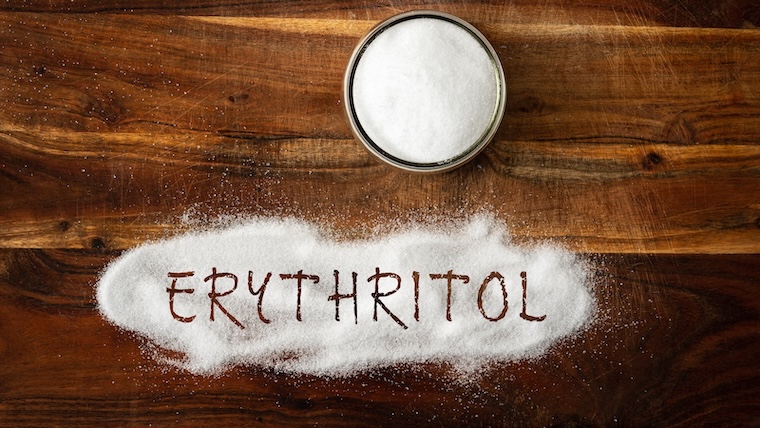Dr. Laybe Norton is more concerned about poor dietary habits than energy drinks.
The sugar alcohol commonly used as an artificial sweetener erythritol is found in sweets, candies, pastries, and numerous other products. (1) With 60-80% of the sweetness of sucrose and virtually no calories, it’s a popular choice for low-calorie and sugar-free foods. Toothpaste, mouthwash, sugar-free energy drinks, and protein bars frequently include erythritol to deliver their sweet flavors without added calories.
A June 2025 study in the Journal of Applied Physiology raised concerns linked to erythritol consumption, suggesting potential adverse effects on brain cells and microvascular health. (2) Previous research has linked elevated blood erythritol levels to an increased risk of stroke and cardiovascular events. (3)
Studies on Erythritol
A close analysis of these studies revealed that the body naturally produces erythritol through the pentose phosphate pathway. (4) Individuals with metabolic dysfunction, often referred to as syndrome X — a condition marked by several cardiovascular disease risk factors — tend to overproduce erythritol due to overactivity in these pathways.
This suggests that the association between erythritol and stroke or cardiovascular events is not necessarily causal. Higher erythritol levels appear to be a byproduct of metabolic dysfunction in those already at risk for these conditions.
2025 Study
The June 2025 study explored whether erythritol has the potential to trigger oxidative stress and cause distinct changes in brain cells.
These are human brain cells in a petri dish. This is an in vitro study.
—Dr. Layne Norton
The number of in vitro studies that pan out into human whole body data is small and could even be smaller than that of animal studies. Scientists conducted an in vitro study by placing brain cells in a petri dish and exposing them to 6µmol/L of erythritol — a concentration equivalent to approximately 30 grams of erythritol, comparable to what might circulate in the bloodstream after consuming an energy drink.
After 24 hours of exposure, researchers observed increased oxidative stress and markers associated with stroke risk. They claimed this represented a physiological dose of erythritol. However, there are several issues with the study’s methodology.

Firstly, the erythritol levels used were roughly twice as high as those typically seen when humans consume 25 grams of erythritol. Moreover, erythritol is largely cleared from the bloodstream within three hours, yet the brain cells in the study were exposed for an extended 24-hour period. Finally, only about 15% of erythritol crosses the blood-brain barrier. (5)
The majority of beverages contain far less than 30 grams of erythritol. “Some of the highest I could find had 15 grams,” Dr. Norton assured. When considering these values, a 25-gram dose of erythritol can elevate levels to a peak of just over 3mm. However, consuming 50 grams may raise levels further, reaching up to 5mm.
This effect is short-lived, lasting less than 24 hours, with only 15% crossing the blood-brain barrier. “What we really have is a dose of erythritol of about 2.25 grams getting to the brain, ” Dr. Norton explained. Consuming around 60 grams of erythritol results in a peak concentration of six milliliters.
That is 27 times the dosage that these cells would actually get exposed to.
—Dr. Layne Norton
Per Dr. Norton, scientists claiming this was a physiological dose of erythritol are mistaken. “There is a huge difference between being exposed in a petri dish 24 hours the entire time, versus a couple of hours at a much lower dose.” Dr. Norton said.
Conclusion
Dr. Norton suggested not to let this study cause alarm, though the possibility that erythritol could have adverse effects remains. Since the evidence is primarily based on in vitro and animal research, supplemented by correlational data from humans, the conclusions are not sufficiently compelling to warrant significant changes regarding erythritol use.
“I’m not really worried about it. If you want to have a few grams of erythritol from an energy drink,” Norton concluded. “I’m more worried about the average person eating more than 3,500 calories per day while getting less than 20 minutes of physical activity.”
More In Research
References
- Regnat, K., Mach, R. L., & Mach-Aigner, A. R. (2018). Erythritol as sweetener-wherefrom and whereto?. Applied microbiology and biotechnology, 102(2), 587–595. https://doi.org/10.1007/s00253-017-8654-1
- Berry, A. R., Ruzzene, S. T., Ostrander, E. I., Wegerson, K. N., Orozco-Fersiva, N. C., Stone, M. F., Valenti, W. B., Izaias, J. E., Holzer, J. P., Greiner, J. J., Garcia, V. P., & DeSouza, C. A. (2025). The non-nutritive sweetener erythritol adversely affects brain microvascular endothelial cell function. Journal of applied physiology (Bethesda, Md. : 1985), 138(6), 1571–1577. https://doi.org/10.1152/japplphysiol.00276.2025
- Erythritol and cardiovascular events. (n.d.). National Institutes of Health (NIH). https://www.nih.gov/news-events/nih-research-matters/erythritol-cardiovascular-events
- Ortiz, S. R., Heinz, A., Hiller, K., & Field, M. S. (2022). Erythritol synthesis is elevated in response to oxidative stress and regulated by the non-oxidative pentose phosphate pathway in A549 cells. Frontiers in nutrition, 9, 953056. https://doi.org/10.3389/fnut.2022.953056
- Van Ommen, B., de Bie, B., & Bär, A. (1996). Disposition of 14C-erythritol in germfree and conventional rats. Regulatory toxicology and pharmacology : RTP, 24(2 Pt 2), S198–S205. https://doi.org/10.1006/rtph.1996.0099
Featured image via Shutterstock/PHLD Luca


